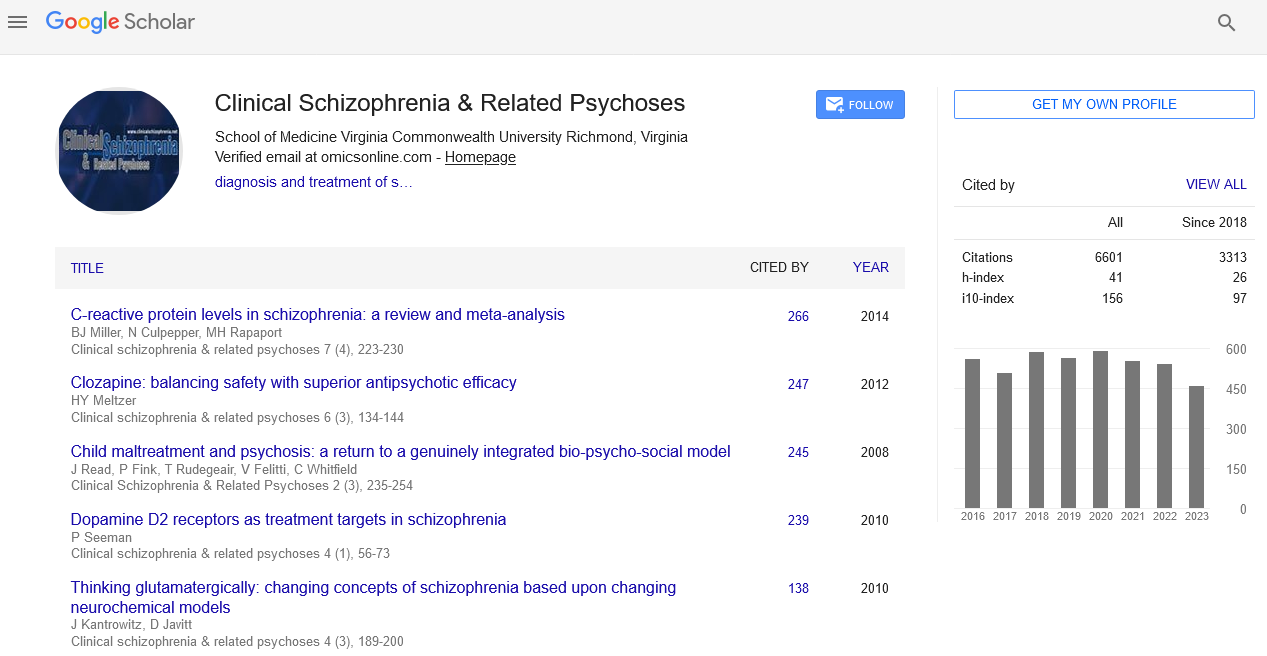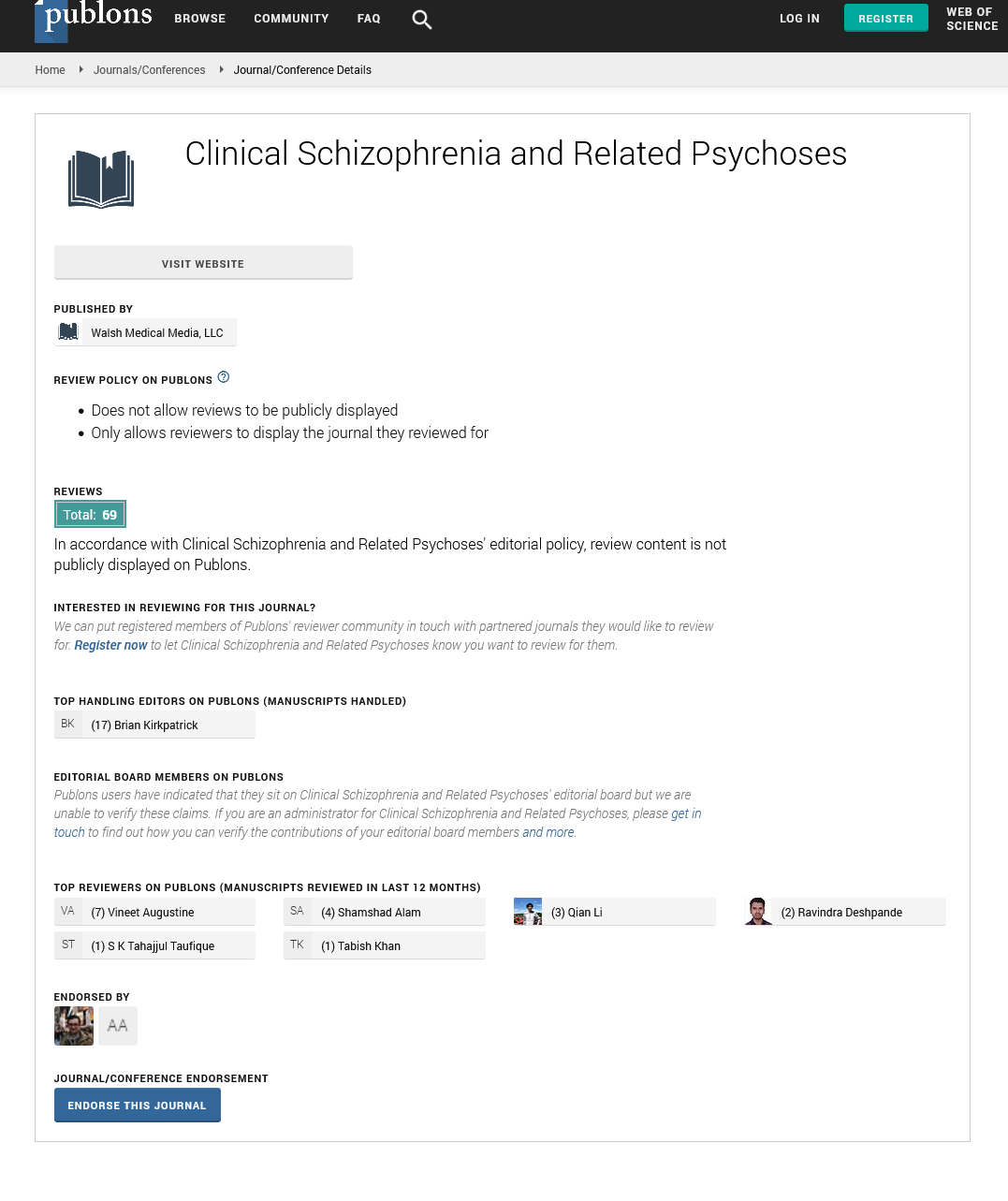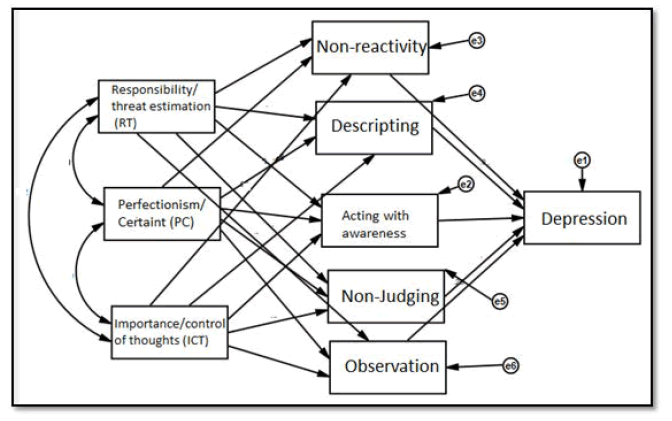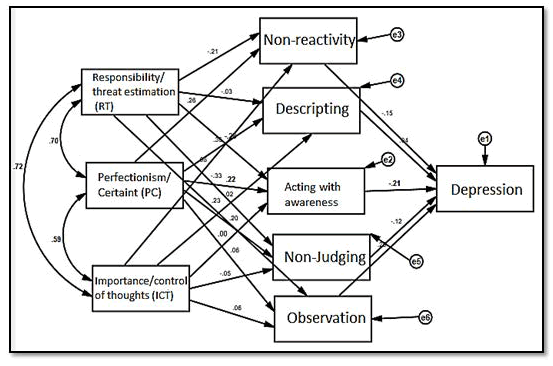Research - Clinical Schizophrenia & Related Psychoses ( 2021) Volume 0, Issue 0
The Mediating Role of Mindfulness Facets in the Relationship between Depression Symptoms and Obsessional Beliefs among University Students
Abdallah Mohamed Abdelzaher Alkholy*Abdallah Mohamed Abdelzaher Alkholy, Associate Professor, College of Education, Prince Sattam Bin Abdulaziz University and Faculty of Education, Assiut University, Egypt, Email: abdallah.khalil@edu.au.edu.eg, am.khalil@psau.edusa
Received: 11-Nov-2021 Accepted Date: Nov 25, 2021 ; Published: 02-Dec-2021
Abstract
The more you are more judgmental and interactive with your negative inner thoughts and feelings, and the more you are less aware of what you are doing at this moment, the more you will definitely bring about anxiety, depression and uncomfort to yourself. The present study aimed at identifying the mediating role of mindfulness facets in the relationship between depression symptoms and obsessional beliefs. The study tools were administered to 500 male and female students at the Faculty of Education, Assiut University. The tools employed in this study included The Five-Facet Mindfulness Questionnaire (FFMQ), the Obsessional Beliefs Scale (OBS) and Beck Depression Inventory-II (BDI-II). The results of the study indicate that acting with awareness and observing mediated the correlations between depression symptoms and obsessional beliefs (importance/control of thoughts). Non-reactivity to inner experience mediated the correlation between depression symptoms and obsessional beliefs (importance/control of thoughts and perfectionism/intolerance of uncertainty). The results of the study also indicate that all mindfulness facets did not affect the correlation between depression symptoms and obsessional (beliefs overestimation of threat/responsibility). The researcher recommends conducting further empirical research on these variables (importance/control of thoughts, acting with awareness, observing, and non-reactivity to inner experience) in order to reach effective remedial interventions to treat anxiety disorders.Keywords
Psychological • Life • Symptoms • Disorders
Introduction
Depression is considered one of the commonest psychological disorders. It is also considered the main cause of disorder and disability in the world. The World Health Organization has issued a warning regarding it for years [1]. Depression and suicide are also considered a source of increased concern on campus [2]. A longitudinal ten-year study has indicated that depression rates increase six times during adolescence [3]. Also the rate of severe depression increases during this stage [4], as it is increasingly recognized as a stage that is characterized by weakness. This accounts for the appearance of many psychological disorders during this stage such as anxiety, depression, and symptoms of obsessive-compulsive disorder [5]. Eisenberge states that the prevalence of depression and anxiety is 16% for undergraduates and 13% for graduate students [6].
The ability of people to be fully aware/mindful of their current experiences and to accept them without judgment or interaction can help them to become aware of their spontaneous habits and negative reactions, to make the most professional choices as well as more efficient and productive decisions and to achieve physical health and psychological well-being. When people feel that they can control their thoughts, they show better immune responses, an increase in life satisfaction and a decrease in anxiety and symptoms of depression [7-10]. Mindfulness is defined as an individual's awareness that is attributed to his/her intended attention of the present, moment by moment, and as his/her failure to judge his/her internal experiences [11]. Mindfullness consists of five facets; namely, observing, describing, acting with awareness, not judging feelings and inner experience or interacting with it.
The study of Petrocchi and Ottavian et al. showed that the skills of not judging play a crucial role in enhancing psychological well-being. In addition, the study conducted by Barnhofer, Duggan and Griffit et al. pointed out that negative emotional interaction is considered a risk factor responsible for the development of the symptoms of depression, their severity and persistence [12,13].
The studies carried out by Yeung and Didonna et al. concluded that creating mindfulness has been negatively associated with depression. Moreover, the findings of the study conducted by Barnhofer, et al. indicated that mindfulness, especially after describing inner experience, is useful in dealing with negative emotions in a way that would reduce the likelihood of the symptoms of depression. Depressive disorder is usually associated with cognitive biases. Researchers speculated that the decrease of metacognitive awareness is positively associated with depression [14-16].
University students go through a period in their life where they grow from teenagers to adults. This phase is referred to as the phase of emerging adulthood [17]. During this period teenagers discover their identities and possible trends in life and they slowly communicate with their future responsibilities. In addition, during this crucial period they face big problems due to academic pressures, personal relationships and their concern for postgraduate life [18]. Concern and depression are consistently included within the top 10 factors that weakens university students' academic performance [2]. These accumulated pressures can endanger their psychological health and increase the likelihood of suffering from depression [19]. Depression may increase the risk of self-injury, dropping college or failure, attempting suicide and other risky behaviors.
The present study aims at identifying the mediating role of mindfulness facets (observing, describing, acting with awareness, not judging feelings and inner experience, non-reactivity to inner experience) and its effect on correlations between the symptoms of depression and obsessional beliefs (overestimation of threat/responsibility, certainty/perfectionism, and control of thoughts/importance).
Methods
Sample and procedures
The research sample consisted of 500 students from the Faculty of Education, Assuit University, who completed the study tools. The data were obtained at the end of January 2021, and the tools were electronically applied. The pilot study consisted of 100 male and female students enrolled in the fourth year at the Faculty of Education, Assuit University, with an average age of (21.20) and a standard deviation of (1.30). The main study included 500 male and female fourth year student (175 male students and 325 female students) with an average age of (21.31) and a standard deviation of (1.38). In choosing the two samples, the pilot and basic samples, the researcher relied on the available sample method.
Scales
The Five-Facet Mindfulness Questionnaire (FFMQ) (translated by the researcher): The Five-Facet Mindfulness Questionnaire (FFMQ) is a multidimensional scale that has been prepared, developed and validated on a variety of samples from the English Academy by Baer, Smith, Hopkins, Krietemeyer, & Toney, L. (2006). This scale consists of 39 items that were distributed through the exploratory factor analysis and the confirmatory factor over five factors: (1) observing, (2) describing, (3) acting with awareness, (4) not judging feelings and (5) non-reactivity to inner experience. The creators of this scale have verified its reliability and validity. The findings pointed out that all mindfulness facets are positively correlated as the results of the exploratory factor analysis and confirmatory factor analysis asserted the five factor model. This scale was translated into many languages of the world and its validity and applicability on these societies have been established. Meng, Mao and Li mentioned that this popularity is due to its good practical psychometric properties. The researcher established its validity and reliability by administering it to the study sample as the coefficients values, using the Alpha Cronbachs Formula, ranged between 0.694 and 0.800 which are acceptable values that indicate its reliability. The correlation coefficient values between mindfulness and the symptoms of depression ranged about 0.154 and it is significant at 0.05 [20].
Obsessional beliefs scale: The obsessive-compulsive knowledge group reduced the six factors of the first version of the Obsessive Beliefs Scale into just three: Responsibility/Threat estimation (RT) which includes 16 expressions, perfectionism/certainty (PC) which also includes 16 expressions; 12 of which are for perfection and the other 4 are for confidence and Importance/Control of Thoughts (ICT) which includes 12 expressions. Thus, the final image of this scale reached 44 expressions. Steketee; Frost and her colleagues of Obsessive Compulsive Cognitions Working Group(OCCWG),2005) verified the reliability of this scale by using the Alpha Cronbach's Formula and it reached 0.9 which is significant at 0.01 and reflects its reliability. The internal consistency method was used to check the scale's internal consistency between total score of the test and the total of the three dimensions and between the dimensions. The correlation coefficients values between the scale and its three dimensions ranged between 0.98:0.83 which is high and reflects the correlation between the dimensions and the scale. The correlation coefficients between the dimensions ranged between 0.88-0.42. The researchers used many methods to check the validity of the scale besides the factor analysis including the concurrent validity where correlation coefficients between the obsessional beliefs scale and the sub-dimensions of Padua's obsessivecompulsive disorder inventory were found: harm impulses, harm thoughts, checking and contamination. The correlation coefficients between the sum of the sample on the obsessional beliefs scale and the sum of the same sample on the dimensions of Padua inventory were significant at 0.01. Moreover, the researcher checked the validity of the obsessional beliefs scale by calculating the correlations among the sum of the sample survey on the scale's three dimensions (responsibility/threat estimation, perfectionism/certainty and confidence and importance/control of thoughts) where the correlation coefficients were 0.188, 0.031, 0.161, 0.136 respectively. The first value was significant at 0.01 while the third one was significant at 0.05. The reliability values ranged between 0.771 and 0.797 by using the Alpha Cronbach's Formula. However, the reliability values ranged between 0.771 and 0.763 by using the Spearman-Brown formula for split-half which were fit and reflect the reliability of the obsessional beliefs scale.
Beck Depression Inventory BDI-II (D-2)
There are two versions of the Beck Depression Inventory (BDI). The first version consists of 21 items that were published [21,22]. This scale has been translated into Arabic and standardized on the Egyptian environment in 1981. It received high correlation coefficients by using various methods (e.g. retesting). The reliability value reached 0.77, which is significant at P=0.01. It also received high validity by finding the correlations between the current scale and the depression scale which is one of the Minnesota's Multiphasic Personality Inventory (MMPI). The correlation coefficients between the two tests reached 0.06, which is significant at P=0.001. Beck Depression Inventory covers 21 items of sadness, pessimism, previous failure, loss of entertainment, guilt, feelings of punishment, self-hate, selfcritism, suicidal thoughts or desires, weeping, irritability and excitability, loss of interest, hesitation, worthlessness, loss of energy, changes in sleep patterns, susceptibility to anger and discomfort, changes in appetite, difficulty in concentrating, exhusation and loss of interest in sex. Every item has four alternatives which are controlled verbal responses with scores ranging between zero and three for each item. The total sum of the scale is the total sum of items. The researcher verified the validity and reliability of this study as the reliability value reached 0.726 which is fit and reflects its reliability by using the Alpha Cronbach formula.
Statistical analysis
Descriptive analysis of the data is performed through IBM SPSS statistic 24 version. The internal consistency (Cronbach’s α) was calculated for all instruments applied. For the purpose of data analysis, the Amos v.24 would be used. First of measurement model testing will be performed by calculating validity and reliability, and then hypothesis will be tested by using mediation analysis. A path analysis was employed to test the mediating effects (indepemdent variable=Obsessional beliefs, mediating variable=Five Facet Mindfulness, dependent variable=depression). The model-data fit of the measurement and mediating models was evaluated with the following five goodness-of-fit indices: χ2/df ratio (acceptable if <3), comparative fit index (CFI, acceptable if >.90), Normed Fit Index (NFI, acceptable if >.95), Goodness of Fit Index (GFI, acceptable if >.95), Incremental Fit Index (IFI, acceptable if >.90) root-mean-square error of approximation (RMSEA, acceptable if <.08) and standardized root-meansquare residual (SRMR, acceptable if <.08) [23].
Results
The results of the study answered the following hypothesis: "Mindfulness as a mediating variable affects the relationship between obsessional beliefs and depressions. A mediation analysis has been conducted to verify the validity of this hypothesis, because the mindfulness variable is one that mediates the relationship between the obsessive beliefs and depression symptoms variables. The mediation model (1) has been tested by using Amos V20 program.
It is clear from Table 1 that the goodness of fit indicies was all acceptable and were within the acceptable limits which shows that the mediation model matches the data. Table 2 illustrates the indirect effects while Table 3 demonstrates the direct effects and their statistical significance for the mediation model (Figure 1).
| Goodness of fit indices | Value | Acceptable value* |
|---|---|---|
| Chi-square | 146.187 | Chi- |
| degrees of freedom | 13 | square/degrees |
| Chi-square/degrees of freedom | 11.245 | of freedom ? 3 |
| Normed Fit Index (NFI) | 0.943 | NFI = 0.95 |
| Comparative Fit Index (CFI) | 0.950 | CFI =.90 |
| Incremental Fit Index (IFI) | 0.960 | IFI = 0.90 |
| goodness of fit index (GFI) | 0.983 | GFI = 0.95 |
| Standardized Root Mean Square Residual (SRMR) | 0.059 | SRMR <0.08 |
| Root Mean Square Error of Approximation (RMSEA) | 0.064 | RMSEA < 0.08 |
| From | Via | To | Unstandardized value | Standardised value | Sig |
|---|---|---|---|---|---|
| Importance/control of thoughts (ICT) |
Observing | Depression | 0.050 | 0.057 | 0.045* |
| Non-Judging | Depression | 0.035 | 0.041 | 0.094 | |
| Describing | Depression | -0.001 | -0.001 | 0.567 | |
| Non reactivity | Depression | 0.027 | 0.031 | 0.050* | |
| Acting with awareness | Depression | 0.052 | 0.059 | 0.015* | |
| Responsibility/Threat estimation (RT) | Observing | Depression | 0.016 | 0.015 | 0.493 |
| Non-Judging | Depression | 0.007 | 0.006 | 0.345 | |
| Describing | Depression | -0.001 | -0.001 | 0.519 | |
| Non-reactivity | Depression | -0.013 | -0.012 | 0.273 | |
| Acting with awareness | Depression | -0.001 | -0.001 | 0.958 | |
| Perfectionism/Certainty (PC) | Observing | Depression | 0.013 | 0.017 | 0.493 |
| Non-Judging | Depression | -0.019 | -0.025 | 0.075 | |
| Describing | Depression | 0.011 | 0.014 | 0.468 | |
| Non-reactivity | Depression | -0.029 | -0.038 | 0.037* | |
| Note: *significant at (0.05), **significant at (0.01) | |||||
| Variables | ||||||
|---|---|---|---|---|---|---|
| From | To | Unstandardized value | Std. error | Standardized value |
Z value | sig. |
| Importance/Control of Thoughts (ICT) | Non-reactivity | -0.088 | 0.047 | -0.210 | -1.85 | 0.064 |
| Describing | -0.015 | 0.061 | -0.027 | -0.25 | 0.803 | |
| Acting with awareness | -0.184 | 0.073 | -0.285 | -2.51 | 0.012* | |
| Non-Judging | -0.196 | 0.067 | -0.328 | -2.94 | 0.003** | |
| Observing | 0.139 | 0.068 | 0.225 | 2.06 | 0.040* | |
| Perfectionism/Certainty (PC) | Acting with awareness | 0.123 | 0.055 | 0.219 | 2.24 | 0.025* |
| Non-reactivity | 0.094 | 0.036 | 0.258 | 2.65 | 0.008** | |
| Describing | 0.176 | 0.046 | 0.363 | 3.86 | 0.000** | |
| Non-Judging | 0.106 | 0.050 | 0.203 | 2.11 | 0.035* | |
| Observing | 0.035 | 0.051 | 0.065 | 0.69 | 0.492 | |
| Responsibility/Threat estimation (RT) | Non-reactivity | 0.041 | 0.051 | 0.080 | 0.80 | 0.424 |
| Describing | -0.015 | 0.065 | -0.022 | -0.23 | 0.821 | |
| Acting with awareness | 0.002 | 0.078 | 0.003 | 0.03 | 0.976 | |
| Non Judging | -0.037 | 0.071 | -0.051 | -0.52 | 0.604 | |
| Observing | 0.045 | 0.072 | 0.060 | 0.62 | 0.539 | |
| Non-reactivity Describing Acting with awareness Non-Judging Observing |
Depression | -0.308 | 0.134 | -0.148 | -2.30 | 0.021* |
| Depression | 0.062 | 0.101 | 0.040 | 0.61 | 0.540 | |
| Depression | -0.282 | 0.087 | -0.208 | -3.24 | 0.001** | |
| Depression | -0.180 | 0.094 | -0.124 | -1.92 | 0.055 | |
| Depression | 0.359 | 0.091 | 0.254 | 3.94 | 0.001** | |
| Note:ÃÂ? *significant at (0.05), **significant at (0.01) | ||||||
Indirect effects
Observing: The results showed that observation affects the correlation between the symptoms of depression and importance/control of thoughts (0.045).
Non-Reactivity: The findings showed that non-reactivity with inner experiences mediates the correlation between the symptoms of depression and importance/control of thoughts (0.050) and the symptoms of depression and Perfectionism/Certainty (0.037).
Acting with awareness: The results revealed that acting with awareness mediates the correlation between the symptoms of depression and importance/control of thoughts (0.015) and the correlation between the symptoms of depression and Perfectionism/Certainty (0.020).
All Mindfullness facets: They haven't mediated the correlation between the symptoms of depression and responsibility/threat estimation.
Direct effects
Acting with awareness: It affected the importance/control of thoughts directly (0.012) and the perfectionism/certainty (0.025).
Not-Judging: It affected the importance/control of thoughts directly (0.003) and the perfectionism/certainty (0.035).
Observing: The findings showed that observation directly affected the importance/control of thoughts (0.040).
Non-Reactivity: non-reactivity directly affected perfectionism/certainty (0.008).
Describing: Describing directly affected perfectionism/certainty (P ≤ 0.001) (Figure 2).
Discussion
The variables were arranged in terms of their effects, from the most effective to the least, according to the presented standardized values in the table of indirect effects (2) and the table of direct effects (3). Regarding the indirect effects, it seems that the facets of acting with awareness and non-reactivity have affected the correlations between depression and obsessional beliefs as mediators (importance/control of thoughts and perfectionism/certainty). This result is consistent with the findings of a study carried out by Michalak, Teismann, Strohle and Vock [24]. The uncertainty beliefs play a major role in concern and depression symptoms. Although some evidence suggest that relationship between uncertainity and depression might be moderate, it is independent. The results of the observation facet showed the correlation between the symptoms of depression and importance/control of thoughts. In order to justify this result, the researcher mentions that the findings of many studies emphasized that conscious observation and mindfulness positively mediate with adaptive structures. Self-concentrated observation, on the other hand, positively correlates and mediates with many non-adaptive structures such as psychological symptoms and suppression of thought. The study of Baer, Smith, Lykins, Button, Krietemeyer, Sauer, Walsh, Duggan and Williams confirm that the observation facet is considered the only facet that showed difference in its results among the five facets [25].
As for the results of the hypothesis of the dimension of acting with awareness, which sums up mindfulness, many studies supported the idea that mindfulness is awareness. The results of this hypothesis confirmed that acting with awareness mediates the relationship between depression and importance/control of thoughts. This indicates the benefits of acting with awareness of what is going on at the present moment and depending on it in treatment interventions in order to manage depression. The findings also showed that the two dimensions of acting with awareness and nonreactivity mediate the relationship between perfectionism/certainty and depression and this is what the study of Flett, Coulter, Hewitt, and Nepon showed as it revealed that rumination mediated the relationship between perfectionism and the symptoms of depression given that rumination is one of the non-adaptive emotion regulation strategies which is the opposite of acting with awareness [26]. Barnes and Lynn's (2010) study also reflected the skills of acting with awareness, non-reactivity and not-judging. The inverse relationship between mindfulness and depression symptoms were enhanced through all periods of academic stress that were evaluated. This result is consistent with the findings of the study conducted by Desrosiers, Klemanski, and Nolen-Hoeksema where rumination and reassessment mediate the correlation between mindfulness and depression symptoms. In addition, the result of this assumption, especially as regards acting with awareness, support the findings of the study undertaken by Lu, Xu, Peng, Wu, Wang, Liu, Xie, Xu, and Li which state that acting with awareness improves and manages the effects of stress on depression [27-29].
The findings showed that all of the five facets of mindfulness have not affected the relationship between responsibility/threat estimation and the symptoms of depression. The study of Pozza and Dettored confirmed that epistemological models assume that the responsibility beliefs are cognitive factors that are highly and particular influenced by obsessive-compulsive disorder [30]. The findings also showed that the dimensions of Describing and not-judging were mediated in the relationship between depression symptoms and obsessional beliefs. This result is different from what was reached in the study of Barnhofer et al. Cash and Whittingham, Jensen, Cohen, Mennin, Fresco and Heimberg who see that these two dimensions have the ability to enhance the inverse relationship between mindfulness and the symptoms of depression [31-33]. They also believe that the ability to describe inner experience is useful in dealing with negative emotions in a way that reduces the likelihood of the appearance of depression symptoms. However, the result of this hypothesis agrees with what was reached in the study of Barnes et al. In which the facet of Describing failed to show any high relationship with the symptoms of depression and with the result of Dreyfus's study which considered 'acceptance' and 'not-judging' as nonbasic elements of mindfulness but instead benefits of it. The findings of the present study are consistent with the studies of Carpenter, Conroy, Gomez, Curren and Hofman, Barcaccia et al. Pagnini et al. Holzel et al. which conclude that perceived control of thoughts is considered important for health and psychological entertainment [34,35]. Moreover, mindfulness skills and non-judgemental awareness of present experiences leads to improving well-being and reducing psychological symptoms and stress. As for the findings of direct effects, the results of the mediating hypothesis or facet of acting with awareness and not-judging showed a direct effect on importance/control of thoughts and perfectionism/certainty. It also showed that the observation facet has directly affected importance/control of thoughts and the non-reactivity and describing facets have directly affected perfectionism/certainty.
The study of Martin and Dahlen points out that those who suffer from depressive disorder are more likely to engage in the strategies of thoughtsuppression in order to control their thoughts that threaten their happiness. These thoughts are related to doubting self-value, the future and rumination of the past. Such thoughts might weaken the individual's feeling of happiness and promote his/her negative humor [36]. The obsessional beliefs (importance/control of thoughts and perfectionism/certainty) are considered functionally disturbed beliefs and the main cause in the persistency of depressive disorder [37]. The findings of the present study are consistent with Beck's theory which assumed that depressive schemas contain disordered attitudes (i.e. a set rigid or inappropriate beliefs and attitudes about oneself or the world). They are also consistent with Ellis's assertion that irrational beliefs (importance/control of thoughts and perfectionism/ certainty) underlie emotional disorders and cause negative feelings such as concern, depression and anger Kuculk, Gur, Sener, Boyacioglu, and Cetindag. The results of the current study increase our understanding of how mindfulness facets work indirectly in the relationship between the symptoms of depression and obsessional beliefs. They also show the role of mindfulness facets (observing, describing, acting with awareness, not-judging and non-reactivity) in influencing those functionally disturbed obsessional beliefs (importance/control of thoughts and perfectionism/ certainty) [38-44].
Conclusion
Moreover, the study offers a practical guide for the workers in the field of offering extension and treatment services in education. It shows that focusing on limiting the beliefs of importance/control of thoughts might be a successful change mechanism that would improve training in mindfulness skills and the well-being of university students. This might also contribute to the decrease in symptoms of depression.
Acknowledgements
The researcher thanks the Scientific Research Deanship at the University of Prince Sattam bin Abdulaziz for encouraging reseachers to publish their research in international journals and for providing training courses with major international companies in order to convey these expreiences. The researcher also thanks the Administration of Assuit University for encouraging researchers to publish their research in international journals and rewarding them with incentives.
References
- World Health Organization. Depression and Other Common Mental Disorders (2017).
- Mackenzie, Sara, Wiegel R Jennifer, Mundt Marion and Brown David, et al. “Depression and Suicide Ideation Among Students Accessing Campus Health Care. Am J or thopsy Chiatry 81 (2001): 101-107.
- Lakdawalla, Z, Hankin, B and Mermelstein. “Cognitive Theories of Depression in Children and Adolescent: A Conceptual and Quantitative Review.” Clinical Child Family Psychology. 5 (2007): 3-4.
- Chambers, Richard, Eleonora Gullone, Craig Hassed and Wendy Knight, et al. “ Mindful Emotion Regulation Predicts Recovery in Depressed Youth.” Mindfulness 6 (2015): 523-534.
- Kroska, Emily B, Michelle L Miller, Anne I Roche and Sydney K Kroska, et al. “Effects of Traumatic Experiences on Obsessive-Compulsive and Internalizing Symptoms: The Role of Avoidance and Mindfulness.” J Affect Disord 225 (2018): 326-336.
- Eisenberg, Daniel, Sarah E Gollust, Ezra Golberstein and Jennifer L Hefner. “Prevalence and Correlates of Depression, Anxiety, and Suicidality Among University Students.” Am J Orthopsychiatry 77 (2007): 534-542.
- Holzel, BK, Lazar SW Gard, T Olivier and ZS Vago, et al. “How does Mindfulness Meditating Work? Proposing Mechanisms of Action form a Conceptual and Neural Perspective.” Perspective Psychological Sci 6 (2011): 537-559.
- Pagnini, Francesco, Katherine Bercovitz and Ellen Langer. “Perceived Control and Mindfulness: Implications for Clinical Practice.” J Psychotherapy Integration 26 (2016): 91.
- Barcaccia, Barbara, Roberto Baiocco, Andrea Pozza and Susanna Pallini, et al. “The More you Judge the Worse You Feel. A Judgemental Attitude Towards One's Inner Experience Predicts Depression and Anxiety.” Personality Individual Differ 138 (2019): 33-39.
- Birtwell, Kelly, Kate Williams, Harm Van Marwijk and Christopher J Armitage, et al. “An Exploration of Formal and Informal Mindfulness Practice and Associations with Wellbeing.” Mindfulness 10 (2019): 89-99.
- Erus, Seher Merve and Esra Tekel. “Development of Interpersonal Mindfulness Scale-TR (IMS-TR): A Validity and Reliability Study.” European J Edu Res 9 (2020): 103-115.
- Petrocchi, Nicola and Cristina Ottaviani. “Mindfulness Facets Distinctively Predict Depressive Symptoms After Two Years: The Mediating Role of Rumination.” Personality and Individual Differences 93 (2016): 92-96.
- Birtwell, Kelly, Kate Williams, Harm Van Marwijk and Christopher J Armitage, et al. “An Exploration of Formal and Informal Mindfulness Practice and Associations with Wellbeing.” Mindfulness 10 (2019): 89-99.
- Yeung, S. “Mindfulness, Negative Cognitions and Mental Health. Discovery- ss Student .” Journal 2 (2013): 49-67.
- Barnhofer, Thorsten, Danielle S Duggan and James W Griffith. “Dispositional Mindfulness Moderates the Relation Between Neuroticism and Depressive Symptoms.” Pers Individ Dif 51 (2011): 958-962.
- Jamshidifar, Zahra, Sara Mohammadizadeh and Niknaz Salehi Moghadam. “Effective Metacognitive Factors in Students’ Depression.” Soc Behav Sci 159 (2014): 16-19.
- Arnett, JJ. “Emerging adulthood: A Theory of Development from the Late Teens Through the Twenties. American Psychologist.” Am Psychol 55 (2000): 469-480.
- Bayram, Nuran, and Bilgel Nazan. “The Prevalence and Socio-Demographic Correlations of Depression, Anxiety and Stress Among a Group of University Students.” Soc Psychiatry Psychiatr Epidemiol 43 (2000): 667- 672.
- Rotenstein, Lisa S, Marco A Ramos, Matthew Torre and J Bradley Segal, et al. “Prevalence of Depression, Depressive Symptoms, and Suicidal Ideation Among Medical Students: A Systematic Review and Meta-Analysis.” Jama 316 (2016): 2214-2236.
- Didonna, Fabrizio, Roberta Rossi, Clarissa Ferrari, Luca Iani and Laura Pedrini, et al. Nicoletta Rossi, Erica Xodo, and Mariangela Lanfredi. “Relations of Mindfulness Facets with Psychological Symptoms Among Individuals with a Diagnosis of Obsessive–Compulsive Disorder, major depressive disorder, or Borderline Personality Disorder.” Psychol Psychother 92 (2019): 112-130.
- Beck, Aaron T, Robert A Steer and Gregory K. Brown. Manual for the Beck Depression Inventory United states, (1996).
- Beck, Aaron T, and Brad A Alford. Depression: Causes and Treatment. University of Pennsylvania Press, United States, (2009).
- Hooper, David, Coughlan J, and Mullen MR. “Equation Modelling: Guidelines for Determining Model Fit.” Electronic J Business Res Method 6 (2008): 53-60.
- Michalak, Johannes, Tobias Teismann, Thomas Heidenreich and Gunnar Ströhle, et al. “Buffering Low Self-Esteem: The Effect of Mindful Acceptance on the Relationship between Self-Esteem and Depression.” Personality Individual Differ 50 (2011): 751-754.
- Meng, Yong, Kaixian Mao and Chaoping Li. “Validation of a Short-Form Five Facet Mindfulness Questionnaire Instrument in China.” Frontiers in Psychology 10 (2020): 3031.
- Baer, Ruth A, Gregory T Smith, Emily Lykins and Daniel Button, et al. “Construct Validity of the Five Facet Mindfulness Questionnaire in Meditating and Nonmeditating Samples.” Assessment 15(2008): 329-342.
- Barnes, Sean M, and Steven Jay Lynn. “Mindfulness Skills and Depressive Symptoms: A Longitudinal Study.” Imag Cognition Personality 30 (2010): 77-91.
- Flett, Gordon L, Lisa-Marie Coulter, Paul L Hewitt and Taryn Nepon. “Perfectionism, Rumination, Worry, and Depressive Symptoms in Early Adolescents.” Canadian J School Psychol 26 (2011): 159-176.
- Desrosiers, Alethea, David H Klemanski and Susan Nolen-Hoeksema et al. “Mapping Mindfulness Facets onto Dimensions of Anxiety and Depression.” Behavior Therapy 44 (2013): 373-384.
- Pozza, Andrea and Davide Dèttore. “The Specificity of Inflated Responsibility Beliefs to OCD: A Systematic Review and Meta-Analysis of Published Cross-Sectional Case-Control Studies.” Res Psychology Behav Sci 2 (2014): 75-85.
- Alsadat Hosseini Ramaghani, Nasrin, Masoud Sadeghi and Khodayar Mehrabi. “A Comparison of the Facets of Mindfulness Among Patients With Major Depression, Social Anxiety Disorder and Healthy Individuals.” Practice Clinical Psychol 5 (2017): 281-288.
- Lu, Fang, Yuanyuan Xu, Yongju Yu and Li Peng, et al. “Moderating Effect of Mindfulness on the Relationships between Perceived Stress and Mental Health Outcomes Among Chinese Intensive Care Nurses.” Front Psychiatry 10 (2019): 260.
- Cash, Morgan and Koa Whittingham. “What Facets of Mindfulness Contribute to Psychological Well-Being and Depressive, Anxious, and Stress-Related Symptomatology?.” Mindfulness 1 (2010): 177-182.
- Dreyfus, G. “Is Mindfulness Present-Centred and Non-Judgmental? A Discussion of the Cognitive Dimensions of Mindfulness.” Contemporary Buddhism 5 (2011): 41-54.
- Jensen, Dane, Jonah N Cohen, Douglas S Mennin and David M Fresco, et al. “Clarifying the Unique Associations Among Intolerance of Uncertainty, Anxiety, and Depression.” Cogn Behav Ther 45 (2016): 431-444.
- Carpenter, Joseph K, Kristina Conroy, Angelina F Gomez and Laura C Curren, et al. “The Relationship between Trait Mindfulness and Affective Symptoms: A Meta-Analysis of the Five Facet Mindfulness Questionnaire (FFMQ).” Clin Psychol Rev 74 (2019): 101785.
- Ku, Y “A Moderated Mediation Model of Negative Life Events, Dysfunctional Attitudes, the Cognitive Triad and Depressive Symptoms.” J Depress Anxiety 6 (2017): 2167-1044.
- Wenzlaff, Richard M, Daniel M Wegner and David W Roper. “Depression and Mental Control: The Resurgence of Unwanted Negative Thoughts.” J Pers Soc Psychol 55 (1988): 882.
- Izquierdo Alfaro, Isabel, Julio Olea Díaz and Francisco José Abad García. “Exploratory Factor Analysis in Validation Studies: Uses and recommendations.” Psicothema 3 (2014): 395-400.
- Martin, Ryan C and Eric R Dahlen. “Cognitive Emotion Regulation in the Prediction of Depression, Anxiety, Stress, and Anger.” Personality Indivi Differ 39 (2005): 1249-1260.
- Nie, Norman H, Dale H Bent and C Hadlai Hull. SPSS: Statistical Package for the Social Sciences. New York: McGraw-Hill, (1975).
- Baer, Ruth A, Gregory T Smith, Jaclyn Hopkins and Jennifer Krietemeyer, et al. “Using Self-Report Assessment Methods to Explore Facets of Mindfulness.” Assessment 13 (2006): 27-45.
- Taber, Keith S. “The Use of Cronbach’s Alpha when Developing and Reporting Research Instruments in Science Education.” Res Sci Edu 48 (2018): 1273-1296.
- Wells A. Metacognitive Therapy for Anxiety and Depression London, UK: Guilford, (2009).
Citation: Alkholy, Abdallah Mohamed Abdelzaher. “The Mediating Role of Mindfulness Facets in the Relationship between Depression Symptoms and Obsessional Beliefs among University Students” Clin Schizophr Relat Psychoses 15S(2021). Doi: 10.3371/CSRP.AAMA.12.09.21.
Copyright: ©2021 Alkholy AMA. This is an open-access article distributed under the terms of the Creative Commons Attribution License, which permits unrestricted use, distribution, and reproduction in any medium, provided the original author and source are credited. This is an open access article distributed under the terms of the Creative Commons Attribution License, which permits unrestricted use, distribution, and reproduction in any medium, provided the original work is properly cited.








